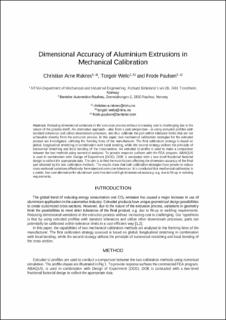Dimensional accuracy of aluminium extrusions in mechanical calibration
Journal article, Peer reviewed
Accepted version

Åpne
Permanent lenke
http://hdl.handle.net/11250/2578307Utgivelsesdato
2018Metadata
Vis full innførselSamlinger
Sammendrag
Reducing dimensional variations in the extrusion process without increasing cost is challenging due to the nature of the process itself. An alternative approach—also from a cost perspective—is using extruded profiles with standard tolerances and utilize downstream processes, and thus calibrate the part within tolerance limits that are not achievable directly from the extrusion process. In this paper, two mechanical calibration strategies for the extruded product are investigated, utilizing the forming lines of the manufacturer. The first calibration strategy is based on global, longitudinal stretching in combination with local bending, while the second strategy utilizes the principle of transversal stretching and local bending of the cross-section. An extruded U-profile is used to make a comparison between the two methods using numerical analyses. To provide response surfaces with the FEA program, ABAQUS is used in combination with Design of Experiment (DOE). DOE is conducted with a two-level fractional factorial design to collect the appropriate data. The aim is to find the main factors affecting the dimension accuracy of the final part obtained by the two calibration methods. The results show that both calibration strategies have proven to reduce cross-sectional variations effectively form standard extrusion tolerances. It is concluded that mechanical calibration is a viable, low-cost alternative for aluminium parts that demand high dimensional accuracy, e.g. due to fit-up or welding requirements.